 12. Electric protection, UPS,
inverter...
12. Electric protection, UPS,
inverter...
12.1. Introduction - 12.2. Operation of a switching power supply - 12.3. Disturbances of the electrical supply network 12.4. Surge outlets - 12.5. Inverter - UPS (Uninterruptible Power Supply)
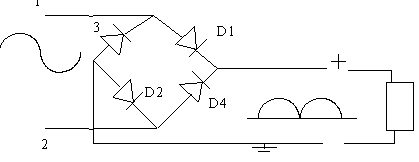 The European electricity network is supplied with 230 V AC (possibly as we have seen in first of the 230 or 380 V three phase). On the other hand, computing devices are supplied with low DC
voltages (generally between + 12 and - 12V). To transform the supply voltage from the mains at acceptable voltage by electronic devices, it uses
power supply.
The European electricity network is supplied with 230 V AC (possibly as we have seen in first of the 230 or 380 V three phase). On the other hand, computing devices are supplied with low DC
voltages (generally between + 12 and - 12V). To transform the supply voltage from the mains at acceptable voltage by electronic devices, it uses
power supply.
In the chapter on the basics of electricity and electronics, we have seen a mounting power supply by rectifier bridge. The power supplies used in computers technologies use switching Power Supply. This principle is not only suited to power supplies, but also to the UPS (UPS in French). Conventional power supplies usually have a near 50 % yield for up to 80 % for the power supplies. Performance (the ratio between power consumption and made power continuous) of these power supplies by bridge rectifier (4 led) after passes through a transformer is too low.
As the bridge is directly on the 230 V AC, consider that half the Assembly is under 230 V. The input signal is a rectified voltage (continued), this electronic installation also allows to boot directly from a DC voltage (batteries, voltaic panels,...)
1. Operation of a switching power supply.
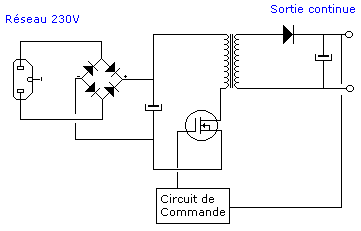 Before we begin, two points are required:
Before we begin, two points are required:
At the price of a PC power supply repair is uneconomic.
Parts are hard to find. The repair technique is more specific to the real electronics and computer technicians. Thus, any repairs are difficult to achieve (otherwise impossible). In addition, precautions in opening these devices are of types "If you put your finger there, is the 230 V AC, there is 380 DC,..." In short, if you don't have serious knowledge of analog electronics (transistors, high voltage), be careful.
Consider the following schema.
The starting voltage is in 230 Volt AC, it is directly rectified by a diode bridge called Graetz bridge without intermediate transformer, coupled with a capacitor (230 V continuous, 330v peak without the capacitor). The following component is a transformer: transformer covered by a direct current to the primary product no signal at the secondary level. On the other hand, if you change an AC voltage to the primary of a transformer, it appears to the secondary voltage of the same shape but different value (a division according to the report the number of input coils / outputs). What can well serve this transformer?
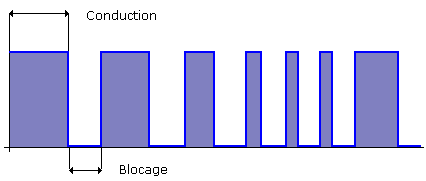 In series with the transformer, it inserts a transistor that will cut the tension, allowing a discontinuous voltage to the primary of the transformer. The base of the transistor (the trigger in CMOS technology) is connected to the secondary of the transformer via a control circuit for the majority of the models via an additional transformer (galvanic separation
protection). This avoids problems in the event of over-voltage on the electrical
network.
In series with the transformer, it inserts a transistor that will cut the tension, allowing a discontinuous voltage to the primary of the transformer. The base of the transistor (the trigger in CMOS technology) is connected to the secondary of the transformer via a control circuit for the majority of the models via an additional transformer (galvanic separation
protection). This avoids problems in the event of over-voltage on the electrical
network.
Turn on and the power supply is not continuous (time to charge the capacitor but also the imperfections of the switch). This tension will first supply the control circuit which will start to chop the DC voltage at the terminals of the transformer.
More the proportion of hash is going to be great on the trigger of the transistor (or base in the case of a bi-polar transistor), more the output voltage will be great. The control circuit will make this cutting vary the output voltage of the power supply and thus regulate the voltage.
2. Disturbances of the electrical supply network.
Let us take again our basic alternating signal.
- Complete failure of the current usually caused by a problem of electrical network or circuit breaker.
- Surge, the mains voltage is higher than the voltage for which power supplies are designed (think of the inputs diodes). This is specific to nearby equipment of electric cabins "high voltage". Even if a surge is necessarily dangerous for computing facilities (in reasonable values), this disturbance causes constraints of all components of the diet, ultimately causing failures.
- Undervoltage, voltage is lower than that for which the power supplies are designed and power knows more provide a sufficient output voltage. In the case of PC power supplies, she descended at least up to 180 v A undervoltage is generally caused by a sudden increase in power consumption over the network by the start of heavy electrical devices: motors, compressors, elevators,... but also by a too large distance from the cabin high voltage. This electrical problem may cause unexpected crashes and crash. They also reduce the lifetime of the computer.
- Transitional. High frequency signals which are superimposed on the electrical signal, they can go up to 4000 Volts, but are weak generally.
- Micro cuts. In low cuts of the electrical signal in a few milliseconds.
- Peaks of tensions: surge for very low time (less than 1/120 second), but high intensity (more than 4000 V), usually due to discontinuation of high power electrical machinery (engines, air conditioners, industrial equipment,...) which dissipate excess tension on the network. Here, too, there is a wear of the components.
- Lightning, also a power surge. Lightning comes from weather (storms) that transfers of high tension electrical but also telephone network. A form of lightning dates back of the Earth, linked to the geology of the ground and thus to a geographical area limited, without actual solutions of protections, even if the proportion is low, less than 1% of cases.
How will behave our switching power supply in these cases:
- Complete failure of the network, no more supply.
- In case surge (up to 280 Volts), the switching power supply will regulate the output but with constraints for electronic components.
- If transitional, primary recovery will reduce the effects, but the transformer will be buffer, it will just reduce the voltage. The capacitor and the self of smoothing to the secondary will just mitigate them. They generally cause blockages of motherboards with the current ATX power supplies. It is identical to the peaks of voltages.
- In the event of microcuts, different capacitors will be used in part to energy reserves.
- In case of lightning, power generally falls down but can also destroy other components of the computer.
3. Surge outlets
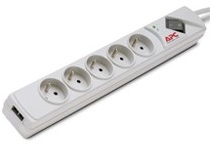 These devices protect only surges (including Lightning). In the case of surges, they disconnect the apparatus from the mains. Cheapest must be replaced after a single significant surge, others allow a
reset. This is not necessarily the solution for professional installations, just a first level of protection.
These devices protect only surges (including Lightning). In the case of surges, they disconnect the apparatus from the mains. Cheapest must be replaced after a single significant surge, others allow a
reset. This is not necessarily the solution for professional installations, just a first level of protection.
4. UPS
A UPS (Uninterruptible Power Supply) includes batteries that supply power connected equipment during a power outage, disconnect the equipment from the network in the event of over-voltage / lightning and regulate the voltage of the system. Three schemas are used:
- On-line
- Line-interactive
- Off-line.
The current UPS connect with software to the computer via USB (serial on older models), which allows turning off the PC itself (including data backup) when prolonged outage. UPS typically allow a power of 10 minutes, the software cutting the computer at least with 5-minute security but it is configurable. Some BIOS's allow to reboot the PC when the voltage is restored.
The power of a UPS is given in VA (Volt - AMPS). The practical equivalence with the power in Watts is 1.6. For example, a 350 Watt consumption requires a 350 X 1.6 = 560 VA inverter. A standard station consumes in 300 Watts. This determines the choice of the power. In the case of under power of the protection device, it will be damaged or will trip failure. Laser printers should not be protected because of the sudden power consumption during the beginning of printing.
Rest batteries. It generally lead technology with an operating voltage of 12 Volts continuous, sometimes connected in series to reach 24 volt and in parallel to increase the duration of power (higher load). These batteries must be completely discharged regularly, to avoid the recharge memory effect, every 6 months on average. It is the same for old laptops, GSM...Some UPS include protections for Ethernet and lines cables telephone.
4.1 Off-line UPS
Off-line models are the most common and used for individual computers, the powers vary from 420 to 800 VA. The electrical network is separated from the device through a relay that opens when you are on or under tension. In normal operation, the input signal is filtered to remove part of the parasites and the converter charge the batteries.
The mains failure or if the voltage is less than 176 Volts or exceeds 280 Volts, the relay opens, separating installation from the electric network. The inverter re-creates the output from the energy of the battery voltage. The reaction time of the relay is relatively high (a few milliseconds) and this technique does not correct the micro cuts.
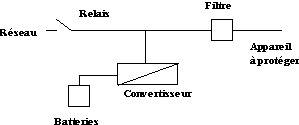
Diagrams of an Off-line UPS
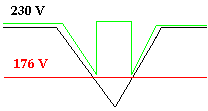
Voltage regulation: In black, evolution of the electrical supply network, in green the output voltage of the inverter
4.2. Line Interactive UPS.
Similar to the off-line, these inverters incorporate a booster that allows to inject additional tension in the event of variations of tensions, but especially prolonged declines. The compensation circuit is just 'booster' output voltage for inputs between 176 Volts (minimum) and 205 Volt voltages, narrowing the constraints of power protection equipment. For voltages of less than 176 Volts or above 280 Volt inputs, operation is identical to the models off line.

Diagrams of an inverter line-Interactive

Voltage regulation
4.3. On-Line UPS
 The operation of an On-Line UPS is significantly different. The input voltage has systematically
redressed and feeds constantly the batteries: the output voltage is therefore stable. This voltage of 12 or 24 Volts is then reprocessed in alternative output voltage of 230
Volts.
The operation of an On-Line UPS is significantly different. The input voltage has systematically
redressed and feeds constantly the batteries: the output voltage is therefore stable. This voltage of 12 or 24 Volts is then reprocessed in alternative output voltage of 230
Volts.
During an over-voltage, batteries will provide electrical power of the equipment connected via the DC converter / AC. If the power goes into slot voltage or in case of a short voltage drop, the used power supply is going to be the power grid helped by charging the batteries, the two are used simultaneously, increasing the duration of protection, in contrast to other types of UPS). Only problem, lead-acid batteries are practically used permanently and finally to replace more often (batteries are almost 2/3 of a price of a UPS). Generally, these models use two circuits of by-pass. The first allows computers without going through the electronics of the ups, used when battery replacement or repair of the inverter. The second bypass is similar to the off-line and increases the service life of the batteries.
12.5. Protections comparisons
| entry | Surge outlets | Off-line UPS | On-line UPS |
| < 180V | Equipment is not supplied any more | opened relay, power supply only by the batteries | Power Supply by batteries and network |
| 180 - 220 V | Normal operation | According to the model, simple voltage regulation or partial intervention of the batteries | Power supply by the network and the batteries so necessary |
| 220 - 240 V | Normal operation | ||
| 240 - 280 V | Normal operation | simple voltage regulation | Power Supply by electric network |
| > 280 V | Abrupt off | Batteries. | |
| High-voltage, the lightning | Abrupt off | Operation by batteries, attention with the times of opening of the relay. | Operation by batteries and cut of the circuit breaker (Reset obligatory) |
| Peak of short duration | No detection generally | Partial filtering | completely removed |
| Micro cuts | Partial filtering | completely removed | |
Electric protection remains a compromise between the price of the protection equipment and the importance of the material to be protected. The safety of a processing server of company requires an inverter online at least, whereas a micro-computer is probably satisfied with a circuit breaker. Lost one hour of production costs definitely more than the price of an inverter. In order to to ensure longer batteries protections, you cannot plug laser printers in an inverter. In this case, the only possibility of electric protection is a surge only outlets. UPS protect only computer and its screen.
As the bridge is directly on the 230 V AC, consider that half the Assembly is under 230 V. The input signal is a rectified voltage (continued), this electronic installation also allows to boot directly from a DC voltage (batteries, voltaic panels,...)
In relation:
- Course: AT and ATX Power supply Types of power supply, cases and format motherboard
- Course: Ethernet by electrical supply network Use of the electrical supply network for the network transfer
|
Next of Hardware 2 course > Chapter 13: corporate network structure |
Hardware course 2: Network, server and communication
© YBET 2006 - 2015
